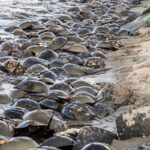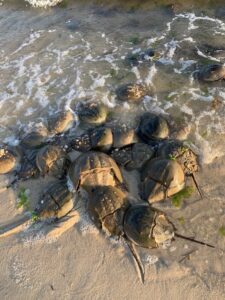Horseshoe Crabs: Coming to a beach near you!
Habitat and History:

Horseshoe crabs in Ocean City are not an uncommon sight. Dating back 450 million years, horseshoe crabs have been given the nickname “living fossils”. Something surprising to note is that horseshoe crabs are actually not crabs at all! In fact, many are fascinated to discover that this species is more closely related to spiders and scorpions than crabs. There are four different species of horseshoe crabs found throughout the world, but only one of those species is found in North America. This species is known as the American horseshoe crab (Limulus polyphemus). This species can be found from Maine, down the Atlantic Coast around Florida, and into the Gulf of Mexico and Yucatan Peninsula. As bottom-dwelling creatures, horseshoe crabs are typically found in deeper estuarine environments or near the continental shelf.

Harmless helmet heads:
When first time you lay eyes on a horseshoe crab, you may see it as a threat. However, these creatures are completely harmless to humans! If you look closely at the head of the horseshoe crab, you will see that it looks like a brownish-green, horseshoe-shaped military helmet. This hard shell is called an exoskeleton and will molt 16 – 17 times as the horseshoe crab grows out of its old shell.
Their exoskeletons are broken into three distinguishable sections: the head, the abdomen, and the tail. The hard exoskeleton protects the head, which contains all the major organs, the mouth, and all five pairs of its’ legs. The abdomen is triangle- shaped with spines on the sides and contains the muscles that move them about and gills that resemble pages in a book. The tail, or telson, is hard and comes to a sharp point. However, there is no need to worry about it hurting you. Their tails are not used to sting or stab, but rather to help steer or flip the horseshoe crabs over if they get stuck upside down.
Another interesting fact about horseshoe crabs is that they have nine eyes spaced around their bodies and an array of light receptors on their tails. Some of these eyes are used to detect light, while others are complex enough to develop images! Next time you see a horseshoe crab, look close to see if you spot any of its eyes!

Sandy Spawning Grounds:
Spawning season in the Coastal Bays is from May to July. The horseshoe crabs will travel from deeper waters in the Atlantic, through the Ocean City inlet, and into our Coastal Bays. During this time, thousands of horseshoe crabs can be seen spawning on our bayside beaches. To tell the difference between a male and female horseshoe crab, look at the size and difference in body structure. The males are approximately 25% smaller than the females and have a clasping claw that is used to hang on to females during spawning. Numerous males will surround a single female in hopes of fertilizing some or all the eggs laid. An individual female horseshoe crab can lay up to 90,000 eggs during a single season! These eggs are also an important food for numerous migrating shorebird species.

Helpful Hint:
To properly handle a horseshoe crab, grab both sides of its shell and gently pick it up. Do not pick the horseshoe crab up by its tail as this can cause harm or cause the tail to break off.
Author Background:
Carly Toulan is an environmental scientist at the Maryland Coastal Bays Program. One of her responsibilities is to work with DNR to help conduct, organize, and schedule volunteers for the annual horseshoe crab surveys. If you have any questions regarding more information on horseshoe crabs or if you would like more information on the volunteer portion of the horseshoe crab surveys, please contact her at ctoulan@mdcoastalbays.org. Please visit Maryland Coastal Bays Program’s website and Facebook to explore more about the bays!

